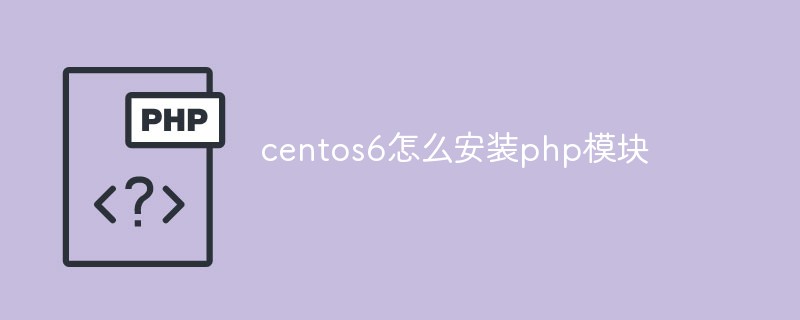
How to install the php module in centos6: 1. Prepare the environment and install dependent packages; 2. Compile and install, add environment variables; 3. Configure Apache to support PHP.

The operating environment of this article: centos 6 system, php 5.6, thinkpad t480 computer.
The following are the steps for compiling and installing php 5.6 (apache module) on centos6.5:
1. Environment preparation
1. Download the php source code package
# wget http://cn2.php.net/distributions/php-5.6.30.tar.gz # tar -xf php-5.6.30.tar.gz -C /usr/local/src/
2. Create www user
# groupadd www # useradd -g www -s /sbin/nologin -M www
3. Install epel source
# yum install epel-release -y
4. Install dependent packages
# yum install gcc gcc-c++ make zlib zlib-devel libxml2 libxml2-devel libjpeg-devel libjpeg-turbo-devel libiconv libiconv-devel freetype-devel libpng-devel gd bison bison-devel readline-devel gd-devel libicu-devel libedit-devel libcurl-devel sqlite-devel jemalloc jemalloc-devel libxslt-devel libmcrypt libmcrypt-devel mhash mhash-devel mcrypt pcre pcre-devel bzip2 bzip2-devel curl curl-devel openssl-devel openldap openldap-devel -y
2. Compile and install
./configure --prefix=/usr/local/php \ --with-config-file-path=/etc/php/ \ --with-apxs2=/usr/local/httpd24/bin/apxs \ --with-mysql=mysqlnd \ --with-mysqli=mysqlnd \ --with-pdo-mysql=mysqlnd \ --with-gd \ --with-iconv \ --with-mcrypt \ --with-mhash \ --with-openssl \ --with-curl \ --with-zlib \ --with-bz2 \ --with-freetype-dir \ --with-jpeg-dir \ --with-png-dir \ --with-xsl \ --with-pcre-dir \ --with-readline \ --with-gettext \ --with-xmlrpc \ --with-libxml-dir \ --enable-shared \ --enable-bcmath \ --enable-soap \ --enable-mbregex \ --enable-pcntl \ --enable-opcache \ --enable-calendar \ --enable-shmop \ --enable-xml \ --enable-sysvmsg \ --enable-sysvsem \ --enable-sysvshm \ --enable-sockets \ --enable-ftp \ --enable-zip \ --enable-gd-jis-conv \ --enable-exif \ --enable-mbstring \ --enable-inline-optimization \ --disable-debug \ --disable-rpath
# make && make install
3 , Configure service
# mkdir /etc/php # cp php.ini-development /etc/php/php.ini
Add environment variable PATH
# vim /etc/profile PATH=$PATH:/usr/local/php/bin export PATH # source /etc/profile
View php configuration file path
# /usr/local/php/bin/php --ini
View php compilation parameters
# /usr/local/php/bin/php-config
4. Configure apache to support php
Modify Apache's configuration file httpd.conf
DirectoryIndex index.html index.php #Add index.php
Find:
AddType application/x-compress .Z
AddType application /x-gzip .gz .tgz
Add the following content
AddType application/x-httpd-php-source .phps
AddType application/x-httpd-php .php
Check LoadModule php5_module modules/ Whether libphp5.so has been added and whether the libphp5.so file exists
Write the test file index.php with the following content and place it in Apache's default Web site directory DocumentRoot #Default path/var/www/html
<?php phpinfo(); ?>
Start the Apache service. If the startup fails, check the configuration file httpd.conf, find the error log error.log, and modify it according to the problem.
service httpd restart
Use a browser to visit http://IP/, if you can see the PHP configuration, it means you are successful
Recommended learning: php training
The above is the detailed content of How to install php module on centos6. For more information, please follow other related articles on the PHP Chinese website!




